
Readers of this site are familiar with Paramount’s (and later Harvey Comics) Little Audrey – a character created to replace Little Lulu in a series of animated theatrical cartoons beginning in 1947.
Based on surviving evidence, the character was designed by Bill Tytla and refined by Steve Muffatti. But what about her name? Where did they get that?
It turns out that like “Tom & Jerry” (the cat and mouse duo – whose name was borrowed from both the Van Beuren characters as well as the famous christmas cocktail) and the “What, Me Worry?” kid (well known for decades before being dubbed “Alfred E. Neuman” for Mad Magazine in the 1950s), the name “Little Audrey” also has a back story, a secret origin, that was perhaps influential in creating the “playful” little lady we know today.
“I figure that when Famous Studios lost “Little Lulu” someone in the company realized that they had a chance to grab something even more famous for absolutely nothing,” movie critic and film historian Eric Lurio recently told me. “Kids in 1947 would have recognized the name immediately.”
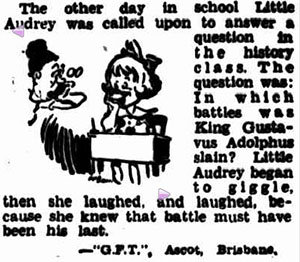 Why? What was “Little Audrey” before Santa’s Surprise (1947)?
Why? What was “Little Audrey” before Santa’s Surprise (1947)?
Apparently she was a ‘name’ first used in a series of jokes popular in the 1930s. Steve Allen mentions “Little Audrey jokes” of the thirties in his history of American humor, Make ‘Em Laugh (1993). Another recent book, American Cornball: A Laffopedic Guide to the Formerly Funny by Christopher Miller, sums it up this way:
During the 1930s, a genre of cruel jokes became popular known as “Little Audrey” jokes. The short jokes were usually pretty macabre, involving various fatal events happening to people. They also featured the catch phrase that Little Audrey “just laughed and laughed”.
In rare cases, the bad stuff happened to Little Audrey and then people “laughed and laughed” at her.
Could this be where animated cartoon Audrey’s annoying laugh comes from?
Here’s a little more detail about the character, in this page out of The American People: Stories, Legends, Tales, Traditions and Songs (1997) by B.A. Botkin.

If you Google “little audrey laughed and laughed” you’ll get all sorts of stuff. Here’s another clipping from a 1930s Brisbane, Australia newspaper (click to enlarge):
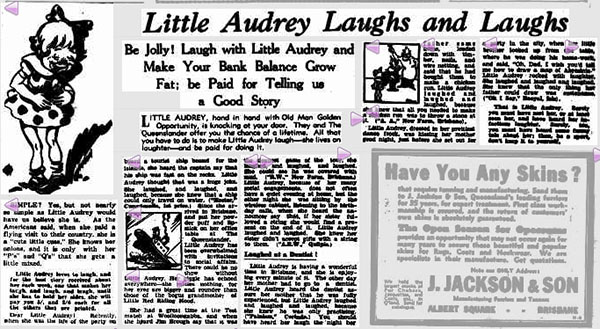
 And speaking of Australia, there was the “Skipping Girl” who was the famous cartoon mascot for Skipping Girl Vinegar since 1936. Their factory on Victoria Street, in Abbotsford, was well-known for its iconic signage. Aussie blogger Danno explains on his Melbourne History website Beside The Yarra:
And speaking of Australia, there was the “Skipping Girl” who was the famous cartoon mascot for Skipping Girl Vinegar since 1936. Their factory on Victoria Street, in Abbotsford, was well-known for its iconic signage. Aussie blogger Danno explains on his Melbourne History website Beside The Yarra:
It wasn’t long before the Skipping Girl sign was dubbed Little Audrey. Little Audrey was a common phrase in Australia at the time, a curious little piece of folk slang lingo. Little Audrey stories were a popular piece of light entertainment, swapped between people like jokes.
In the stories, Little Audrey would normally be wide eyed and naive and would have some humourous interaction with someone older or more discerning. Audrey would ofetn say or do something daft, which provided the punchline. Competitions were held, asking people to submit their favorite Little Audrey Stories.
Interesting to note that Paramount’s first merchandising art of their “Little Audrey” has her skipping rope.
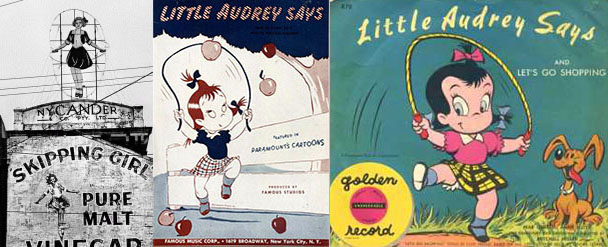
The name “Little Audrey” was so well known – from either joke books or Vinegar labels – that a famous British tank that took part in the D-Day landings, well before Santa’s Surprise was even conceived, was dubbed “Little Audrey II” (a “Little Audrey I” commemorates the vehicle today in England – photos below).

After the war, Famous Studios adopted the name, her mischief and her laugh – and the rest is history. According to Eric Lurio, who searched the character trade mark registration, “Little Audrey” was only ever trademarked by Harvey – as PLAYFUL Little Audrey™ – in 1960. “I guess that they knew the name “Little Audrey” was in the public domain and had been for decades – and it took them twelve years to figure out how to do it.”
As for the original “Little Audrey” of American folklore… she still lives on. Here’s an excerpt from the book Little Audrey, a 1998 novel by Ruth White, which intertwines the traditional Audrey character with a fictionalized memoir of the author.

(This post was written with assistance from Eric Lurio and information obtained from various sources, including Australian blogger Danno.)


 Jerry Beck is a writer, animation producer, college professor and author of more than 15 books on animation history. He is a former studio exec with Nickelodeon Movies and Disney, and has written for The Hollywood Reporter and Variety. He has curated cartoons for DVD and Blu-ray compilations and has lent his expertise to dozens of bonus documentaries and audio commentaries on such. Beck is currently on the faculty of CalArts in Valencia, UCLA in Westwood and Woodbury University in Burbank – teaching animation history. More about Jerry Beck [
Jerry Beck is a writer, animation producer, college professor and author of more than 15 books on animation history. He is a former studio exec with Nickelodeon Movies and Disney, and has written for The Hollywood Reporter and Variety. He has curated cartoons for DVD and Blu-ray compilations and has lent his expertise to dozens of bonus documentaries and audio commentaries on such. Beck is currently on the faculty of CalArts in Valencia, UCLA in Westwood and Woodbury University in Burbank – teaching animation history. More about Jerry Beck [



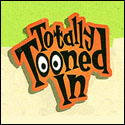



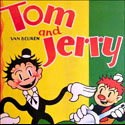
What about the St. Johns comic series from 1948-49? Did anyone from Famous Studios draw that series? And if so, why didn’t they advertise that this was a Famous Studios character on the covers as the Harvey issues did later?
Bill Tytla drew covers, and Steve Muffatti drew stories. As far as Famous Studios/Paramount’s namesake, that was all down to whatever the licensing agreement was. It likely didn’t stipulate St. John’s had to use it. The Dell Animal Comics only occasionally had the Famous logo, and only a handful of Real Screen Comics bear the line “Published by Arrangement with Columbia Pictures.”
Milton Knight asked me to add that Vince Fago drew a lot of the St. John’s series of Audrey.
I don’t know about whether or not anyone from Famous Studios did the St. John’s comics, but in 1948, with only a couple of shorts in the can, the little girl in the schoolyard jokes was lot’s more famous.
There were also very few TVs in 1948, and Famous/Paramount characters weren’t nearly as popular as they were after Harvey started selling it’s Afternoon TV package in the 1950s.
I am one of her biggest fans. I aDORED getting “the low-down!” Grrrrreat stuff!!!
I am, too!!
Just to demonstrate the linkages that phrases have, (cartoon) Tom & Jerry may have been named for the drink, but the drink was named for the creation of Pierce Egan. They first appeared in print in 1821 in a book entitled Life in London or, the Day and Night Scenes of Jerry Hawthorn, esq., and his elegant friend, Corinthian Tom, accompanied by Bob Logic, the Oxonian, in their rambles and sprees through the Metropolis..
Bob
Still doesn’t explain where Audrey’s perpetual bouts of narcolepsy came from (the girl could fall asleep in a boiler factory…)
Bandleader Kay Kyser, who was quite popular from the late 1930s into the late ’40s, had a male vocalist named Harry Babbitt, who occasionally sang novelty tunes in a high-pitched voice. Kyser often made spoken introductions to songs just before the vocal refrain, and on those particular records that had Babbitt singing in the high-pitched voice, Kyser always referred to the vocalist as “Little Audrey.” I always assumed the name was picked up from the jokes.
Note to Jon: One record on which Harry Babbitt (usually a singer of romantic ballads) uses his falsetto “little child’ voice, and is NOT credited as “Little Audrey” was the hyper-successful release of “Three Little Fishies”. Babbitt is heard in each of the four vocal choruses, identified by Kyser as “Boopy-Doopy-Doop. . . Babbitt!” (Other vocalists heard are Sully Mason, Virginia (Ginny) Simms and Merwyn “Ish Kabibble” Bogue.
I don’t know how you learn all this stuff, Jerry. I never heard of a ‘Little Audrey Joke” before. I didn’t know the character had a life outside of the Famous Studios cartoons. You are a true pioneer of information about a “despised medium”. Now I know why Little Audrey just laughs and laughs (especially in the last scene of her cartoons).
Thanks for telling everyone about this, Jerry! I love the Little Audrey cartoons!
Isn’t it odd that the Little Audrey cartoons sanitized the macabre nature of the original jokes – – yet they were made by the same folks who were gave us Herman and Katnip!
I would like to point out that, contrary to what countless cartoons both on the screen and in print (as see Little Audrey above) would have you believe, it is neither practical nor safe to attempt to scrub a floor by attaching brushes to your feet. Don’t try it, and especially don’t try to do it with bars of soap, even if you are a mouse. This could lead to serious injury, and it is no laughing matter.
Any idea where they got the idea to name her comic book co-star Melvin? I know the name turned up often in MAD when it was still a color comic book. (It also turned up in sister publication PANIC, and even in a couple of the Crypt Keeper’s stories.)
Hi everyone. I have just found a ‘Little Audrey’ 64 page book including 4 full-colour pages. The intriguing aspect that this was a gift to someone as the date is 1923. Can anyone give me any more information as this book looks really old?
I’d love to see that book. Any way to scan the cover and some pages?
When I was a child my father bought or had a hardcover brown or maroon book which I loved to read with only lots of Little Audrey stories in it. This was in the late thirties or early forties. Does anyone else know of such a book. I have no idea what happened to our copy and I don’t remember anyone else having the book.
(I;ve also posted this as a regular posting)
I’m looking for the little Audrey doll I had when I was little. I remember she had a red outfit on (PJ’s maybe?) and I think a blue ribbon in her redish brown hair. I would love to get another doll like this. Does anyone know where to get one? thanks!
I have a little Audrey doll, she is from the 40’s, no clothes, cloth body.
When I was a child my father bought or had a hardcover brown or maroon book which I loved to read with only lots of Little Audrey stories in it. This was in the late thirties or early forties. Does anyone else know of such a book. I have no idea what happened to our copy and I don’t remember anyone else having the book.
Never knew that. Wonderful research Jerry!
Very interesting and enlightening. Did not know the whole story of Little Audrey before.
The late (and yet much esteemed) Canadian historian Pierre Berton has this interesting specimen of a Little Audrey joke as had some currency around the time the Dionne Quintuplets were born in 1934 from his rather impressive biography The Dionne Years: A Thirties Melodrama (1977):
Little Audrey’s mother asked her to buy some groceries at the Safeway and the laughed and laughed because she knew there would be no safe way.